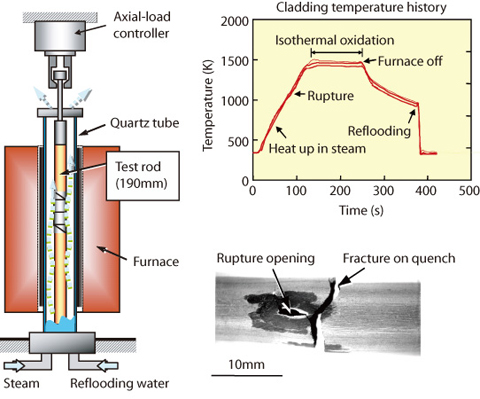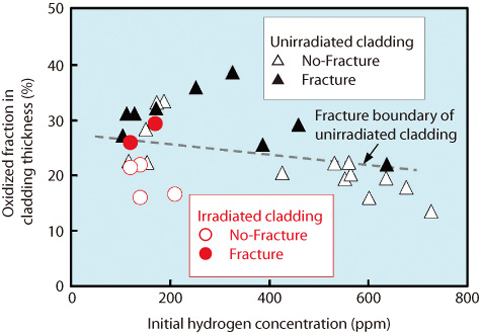
Fig.5-7 LOCA-simulated experiment

Fig.5-8 Fracture map, relevant to oxidized fraction and initial hydrogen concentration
The loading period of fuel (fuel burnup) is being increased step by step in light water reactors (LWRs) for efficient use of natural resources and reduction of spent fuels. This should be achieved without degrading the safety. We perform experiments under simulated accident conditions to investigate effects of longer-term irradiation on fuel behavior during accidents and confirm fuel safety.
In a postulated loss-of-coolant accident (LOCA), fuel temperature is increased for several minutes until the emergency core cooling system (ECCS) recovers the coolability of the reactor core. Fuel cladding, composed of zirconium-based alloys, becomes brittle if it is severely oxidized during the high-temperature period, and may fracture by thermal shock during the emergency core cooling. Heat removal may not be possible in the case that fragments from the fractured fuel accumulate in the lower part of the reactor core. To maintain coolable geometry of the reactor core, the Japanese LOCA criteria require that the peak clad temperature shall not exceed 1473 K (1200°C), and the oxidized fraction shall not exceed 15% of the cladding thickness. The 15% criterion is based on fracture/no-fracture boundary conditions determined by laboratory-scale experiments simulating LOCA conditions. Since most of the previous experiments used only unirradiated cladding, information regarding irradiated cladding was insufficient. Hence, we devised a simulating apparatus (Fig.5-7) in a hot-cell and performed the LOCA-simulating experiments with cladding that had been irradiated for a long term (burnup: 39 to 44 GWd/t) in a commercial pressurized water reactor (PWR). As a result, important information was obtained on overall behavior and fracture conditions of irradiated cladding under LOCA conditions. Fig.5-8 shows that fracture conditions of the irradiated cladding are identical to those of unirradiated cladding which has been equivalently pre-hydrided simulating hydrogen absorption that occurs during reactor irradiation. Accordingly, the fuel safety in a LOCA is not degraded by long-term irradiation of the examined range, though the fracture boundary oxidation value is reduced by hydrogen absorption to some extent. The obtained information is used in the regulatory judgment by the government